33 Under Ben Bulben
Posted by Christine on Feb 2, 2015 in Ireland | 3 comments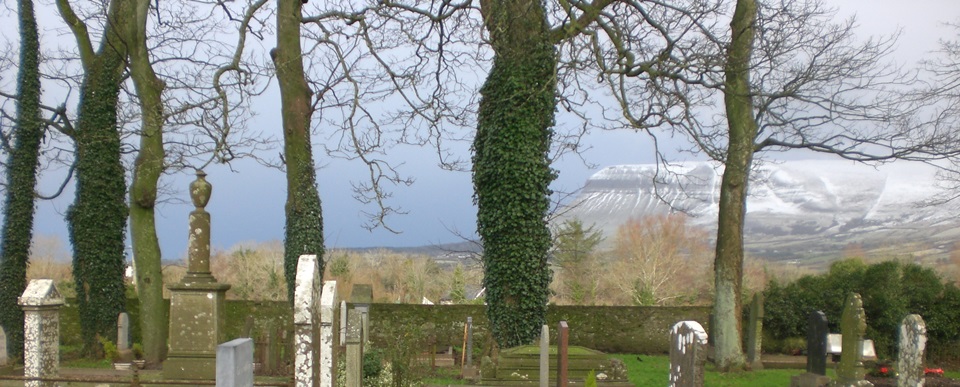
One of my favorite photos of Ireland is a lucky shot I took of William Butler Yeats’s grave at Drumcliff Churchyard with Ben Bulben, an iconic mountain just north of Sligo town, looming in the background. The photograph was made with a nothing little point-and-shoot in January 2010 on the sixth Agnes Scott student trip to Ireland.
The mountain, shown in the top half of the photo featured above, is beautiful enough on its own and has a thousand faces, changing its look and mystery with every shift in the weather, every angle of the sun or shadow of a cloud, every different position from which the photographer tries to shoot. Yeats’s grave is located in a small churchyard on the plain to the south of the great mountain and is one of the most important sites of our trip, as well as a very popular stop for any Yeats lover who comes to this part of Ireland. Not long before he died, Yeats wrote a poem about this spot called “Under Ben Bulben,” a meditation on life and death, war, mythology, nationality, and the importance of art. By projecting the speaker’s voice to the future, he inscribes in the poem’s last section his wish to be buried in Drumcliff Churchyard at the foot of the mountain, even including his chosen epitaph:
Under bare Ben Bulben’s head
In Drumcliff churchyard Yeats is laid.
An ancestor was rector there
Long years ago, a church stands near,
By the road an ancient cross.
No marble, no conventional phrase;
On limestone quarried near the spot
By his command these words are cut:Cast a cold eye
On life, on death.
Horseman, pass by!
The dramatic features of the landscape around Ben Bulben create a suggestive backdrop for storytelling and figure prominently in the “mythohistory” of the land. In Celtic mythology, the Fianna, a band of warriors on horseback, used Ben Bulben as their hunting grounds and are said to be buried or held inside the mountain, waiting to be summoned for a new cause. Was that story the source of the “horseman” mentioned in the epitaph Yeats wrote for himself? Or was he thinking of the horsemen of some other myth, or of the apocalypse? Diarmuid and Gráinne [GRAWN-ya], who formed a legendary love triangle with the leader of the Fianna, Fionn mac Chumhaill [FIN muhCOOL], are also supposed to be buried there. In the sixth century St. Columba fought a crucial battle under Ben Bulben over the ownership of a decorated psalter he had copied, an incident that is called the first copyright case with its final determination, “to every cow its calf; to every book its copy.”
As a child and young man, Yeats spent a lot of time in Sligo; the region’s rich mythological associations inspired his vision for the Celtic Revival, a literary movement that drew on native sources for stories and themes. He never lost sight of his Sligo roots, and today “Yeats Country” marks the poet’s residences and haunts. Yeats died in France in 1939, and because of the war, was buried there until 1948, when his coffin was brought home by ship to Sligo with great ceremony, including a procession from Sligo Bay to Drumcliff with many of the country’s dignitaries on hand. His grave is exactly as he wished, with a limestone marker and the enigmatic three lines engraved on it.
My uncropped photograph of Ben Bulben, Yeats’s grave, and four of the students who were with me that winter reveals the full setting for these stories, myth and history, and for stories of my own encounters with Yeats and with Ireland.
To understand the serendipity of this photo, it’s important to know that the winter of 2009-10 was an epic one in Ireland with freezing temperatures, ice, and snow caused by the so-called polar vortex. Records for cold and snowfall were set in Ireland and the UK that year, only to be broken the next year with an equally anomalous repeat of the phenomenon. Thanks to the Gulf Stream and other factors, the weather here is remarkably stable from year to year, or at least has been so until climate change started to shake things up a bit in our time. Winter temperatures are almost always in the 40s°F. with the occasional blip upwards or downwards, but not by much. I’ve done eight student trips to Ireland in December-January and quite a few family trips during the same period: the winter of 2009-10 was the only time I experienced anything like a continental winter, with many consecutive days of freezing temperatures accompanied by significant snow and ice. Ireland is not prepared for such weather—not then and not now.
Our group ran into weather induced problems from the second day of the trip. The frost and snow were beautiful all right, but the icy roads meant that the bus just couldn’t go everywhere we wanted to go. Betting that the weather would improve, at first we switched things around, putting indoor and main-road activities before hilly treks and backroad destinations. As it became clear that no thaw was imminent and that the white stuff would continue to fall, we had to drastically change our itinerary, cancelling many planned visits and scheduling new ones that were reachable and open.
The morning of the photograph, we were leaving Sligo town and setting out for Derry/Londonderry, intending to stop at four important Yeats’s sites, including his grave, before arriving in Derry by midafternoon. Though there was no snow on the ground in Sligo—just a bit on the tops of nearby mountains—it soon became clear that we would have to ditch most of the Yeats sites because of icy roads surrounding the lakes to the east and south of town: the Rock of Dooney that inspired Yeats’s poem “The Fiddler of Dooney”; the Lake Isle of Innsifree, source of the poem of the same name; and Glencar Waterfall, the setting for “The Stolen Child.” On our trips the students love these outdoor places and the poems they inspired. As is our custom, students read aloud from the relevant works of literature at most of our stops, and I already had a full slate of eager readers for the beloved poems planned for the “Yeats day.” Disappointed but undaunted, the students took the changes to the itinerary philosophically. Because of the weather, we had extra bonding time as a group, so friendships and the general esprit de corps on that trip were even stronger than usual.
Fortunately for us, Drumcliff Churchyard is on the main road, and we could be fairly certain of decent driving conditions and safe parking and walking. Everyone was glad that at least one Yeats site remained accessible to us. If you look at the sky around the mountain in the photo, you can see the darkening blank of coming snow. We recognized that, too, but when we pulled up to the churchyard, the students were eager to get off the bus, so we ended up spending more than our usual time at Drumcliff, taking the opportunity to read some of the poems we had missed out on earlier in the day and knowing this might be our last chance for a while to linger outside.
The photo was taken just before our departure from Drumcliff. Megan (the one in the white hat holding the book of poems) was a Yeats fanatic—we usually have a couple of these at least on our trips—and had signed up days before to read “Under Ben Bulben” aloud here. I remember her reading that long poem with great care and eloquence, not once but three times while we were at Drumcliff: once for all of us to hear in the nave of the tiny church, once at the grave for a few lingering devotees, and once again at the grave for herself. Amy, Ellen, and Qian (left to right), were avid fans and stuck it out with Megan, even as the others gave in to the cold and headed for the bus. I snapped a couple of photos of the moment, but didn’t realize until I looked at them on my computer later that night how perfectly this one had turned out. You have to stand in just the right place to get Ben Bulben and the entire Yeats grave in the frame, and by a stroke of dumb luck, the snow-capped mountain, the students, and even the lichens on the gravestones are in focus. You can see “W. B. Yeats” carved on the curb along the side of the grave. I love the happy but thoughtful looks on the students’ faces. Ireland’s legendary green glows in this vista, and the lighting suggests both the fleeting sun and the coming snow, a moment of transformation worthy of a poem.
For me, this photo captures the essentials of our student trips: the incredible Irish landscape, full of dramatic juxtapositions and surprises, always in flux, always green even right before a snowstorm; the students’ dedication to the literature and history we study, their willingness to withstand the weather in order to experience the places where the literature was born or buried, and their support and friendship for each other; my own fortune in being able to read poetry together with eager audiences in places like Drumcliff Churchyard, even in the bitter cold.
This image also reminds me of how important the before and after of a photo are to the story. Shortly after it was taken, we all piled onto the bus just as the first flakes of the coming storm were beginning to fall. The road we took north winds around Ben Bulben to the west, so we had the mountain in view for a while and watched it quickly become blanketed, then obliterated, in snow. We soon realized we were in the midst of a blizzard—not as dramatic as a blizzard in Buffalo, New York, or the Northwoods, but for Ireland, a blizzard nonetheless. For most of the drive north, our bus was the only vehicle in sight. Fifteen minutes after leaving Drumcliff, we stopped just up the road at Creevykeel, a megalithic court tomb over five thousand years old, for a brief visit. Here is what we found.
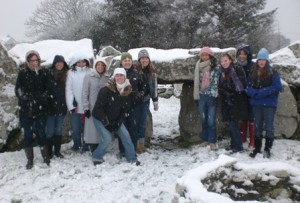
In a very short while, the landscape had transformed, our Yeatsian moment under Ben Bulben whited out as was pretty much everything in the area. We had visited Drumcliff in the nick of time. Even if we had trudged to the grave in falling snow, we wouldn’t have been able to have seen the mountain and its mythologies looming in the background, so essential to an understanding of “Under Ben Bulben” and much of Yeats’s poetry.

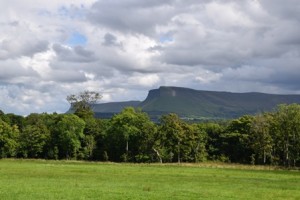
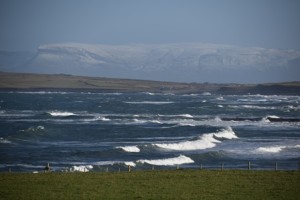
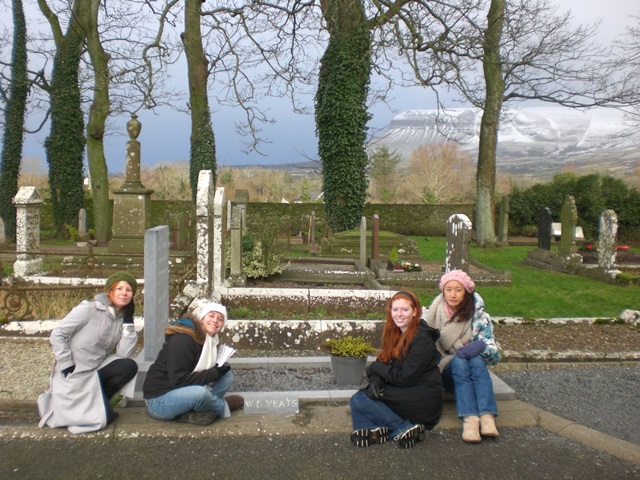
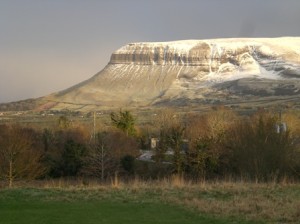
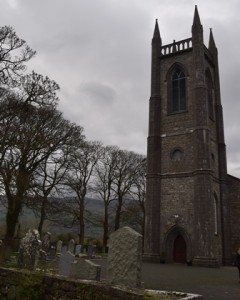
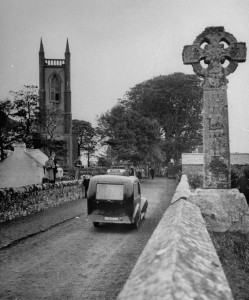
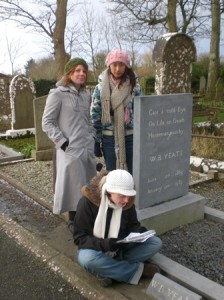
The Ireland trip was absolutely the highlight of my college life. The other day, I found the assembled Irish Literary Trip Book and read some poetry! I am so thankful for the Ireland trip and the Irish Literature class taught by Dr. Cozzens!!!
Christine, Wonderful! I look forward to spending time with you in Ireland, virtually. Best, Joe Iarocci
Thanks for reading, Joe!